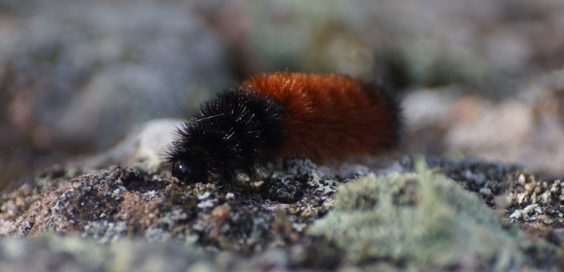
Creature Feature – The Woolly Bear Caterpillar
Posted by Dustin Horton // September 18, 2019 // Articles, Creature Feature // 2 Comments
This fuzzy orange and black caterpillar is a sure sign of autumn. It’s actually the larval form of the attractive Isabella tiger moth. Most of this species’ eggs hatch in the fall, which is why we mostly see the woolly bear during this season. The caterpillar is not picky – it is a generalist feeder, and consumes a wide variety of plants, like dandelion, nettle and plantain. While typically nocturnal, this cannot be exclusively so, as we often spot a woolly bear – or 2 or 3 — crossing the road in broad daylight. As temperatures dive, the woolly bear seeks a protected place, in a log or another safe, cozy crevice. There it goes into hibernation for the winter, surviving temperatures as low as -90 degrees Fahrenheit. Thanks to a sort of “antifreeze” it produces, the caterpillar may freeze, but its organs are protected. With spring’s arrival, the caterpillar thaws and goes on an eating bonanza before spinning a cocoon from its own fuzz. 10-15 days later, it emerges as an adult moth. Popular folklore claims that the severity of winter can be predicted based on the woolly bear’s orange and black bands: the wider the orange bands, the milder the winter; thicker black means a harsh season ahead. (Fear not! All black caterpillars are a different species!)
Article & Photo by Margie Manthey














2 Comments on "Creature Feature – The Woolly Bear Caterpillar"
I saw an all white one with a black stripe. Does that mean a terrible winter?
Hi Bob,
Thanks for your question about the all-white caterpillar you spotted. This is a different species from the woolly bear, which is always some combination of black and rust colored bands.
We shall have to wait and see what this winter will be like, but most of the woollies I’ve seen have had slightly more rust than black bands, which supposedly forecasts a bit of a milder winter. So far it doesn’t seem to be true!
Margie Manthey